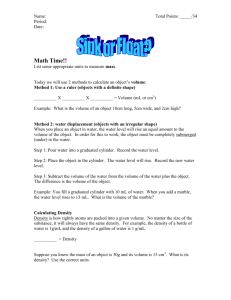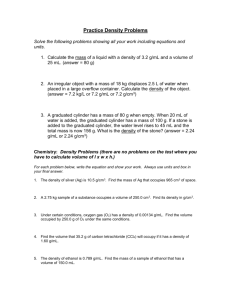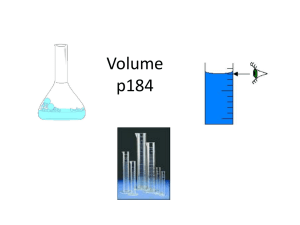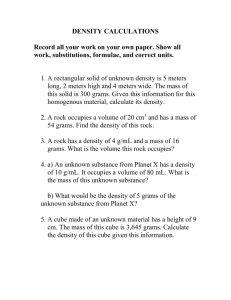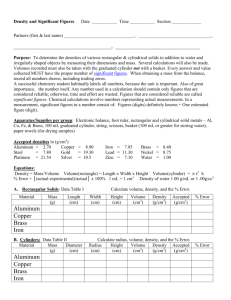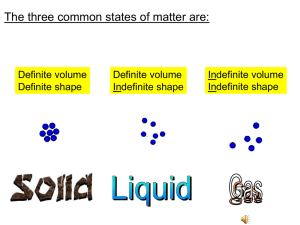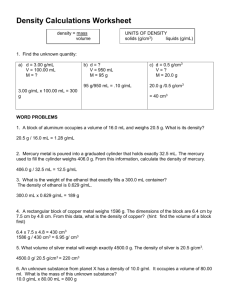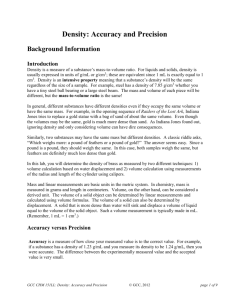Density test review packet Answer key
advertisement
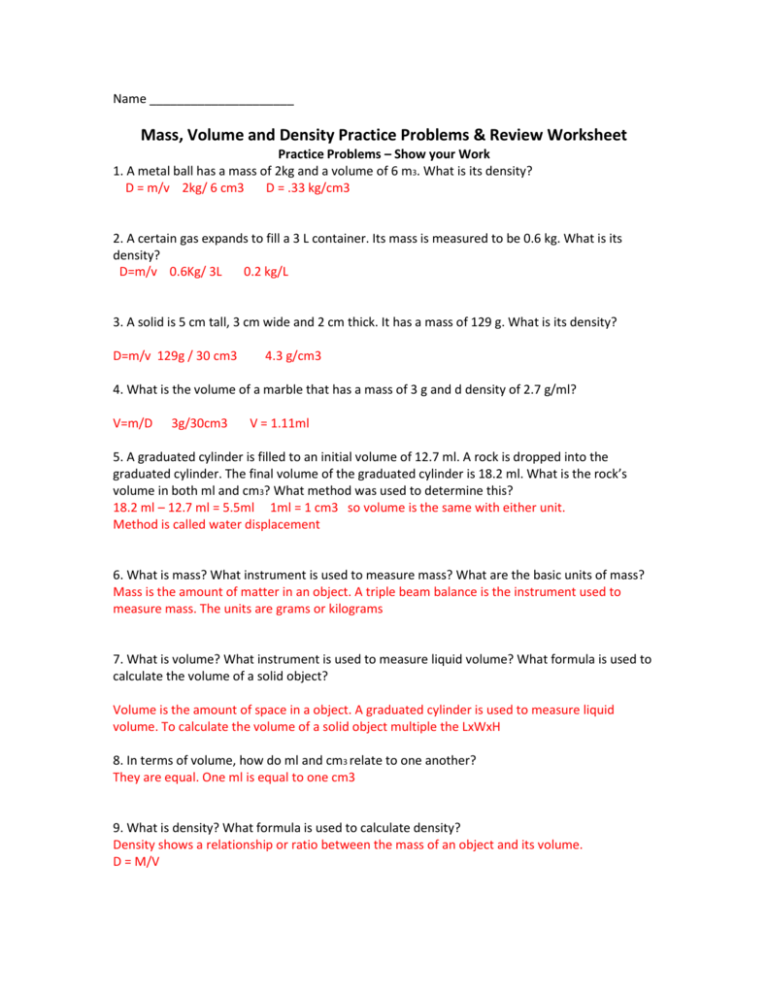
Name _____________________ Mass, Volume and Density Practice Problems & Review Worksheet Practice Problems – Show your Work 1. A metal ball has a mass of 2kg and a volume of 6 m3. What is its density? D = m/v 2kg/ 6 cm3 D = .33 kg/cm3 2. A certain gas expands to fill a 3 L container. Its mass is measured to be 0.6 kg. What is its density? D=m/v 0.6Kg/ 3L 0.2 kg/L 3. A solid is 5 cm tall, 3 cm wide and 2 cm thick. It has a mass of 129 g. What is its density? D=m/v 129g / 30 cm3 4.3 g/cm3 4. What is the volume of a marble that has a mass of 3 g and d density of 2.7 g/ml? V=m/D 3g/30cm3 V = 1.11ml 5. A graduated cylinder is filled to an initial volume of 12.7 ml. A rock is dropped into the graduated cylinder. The final volume of the graduated cylinder is 18.2 ml. What is the rock’s volume in both ml and cm3? What method was used to determine this? 18.2 ml – 12.7 ml = 5.5ml 1ml = 1 cm3 so volume is the same with either unit. Method is called water displacement 6. What is mass? What instrument is used to measure mass? What are the basic units of mass? Mass is the amount of matter in an object. A triple beam balance is the instrument used to measure mass. The units are grams or kilograms 7. What is volume? What instrument is used to measure liquid volume? What formula is used to calculate the volume of a solid object? Volume is the amount of space in a object. A graduated cylinder is used to measure liquid volume. To calculate the volume of a solid object multiple the LxWxH 8. In terms of volume, how do ml and cm3 relate to one another? They are equal. One ml is equal to one cm3 9. What is density? What formula is used to calculate density? Density shows a relationship or ratio between the mass of an object and its volume. D = M/V 10. A box 5 cm long, 4 cm wide and 6 cm high would have what volume? Show your work! V= Lxwxh 5 cm x 4 cm x 6cm = 120 cm3 11. Samples of three unknown liquids have been obtained. Calculate the density of each. Show your work! - Sample A has a mass of 24.0 g and a volume of 6.0 ml. D=m/v 24.0g/6.0ml = 4 g/ml - Sample B has a mass of 12.0 g and a volume of 6.0 ml. D=m/v 120g/6.0ml = 20g/ml - Sample C has a mass of 12.0 g and a volume of 3.0 ml. D=m/v 12.0g/3.0 ml = 4 g/ml 12. A graduated cylinder contains 17.5 ml of water. When a metal cube is placed onto the cylinder, its water level rises to 20.3 ml. Calculate the following: 20.3 ml – 17.5 ml - Volume of the cube: ___2.8___ml - Volume of the cube ___2.8___cm3 13. How would you properly measure the mass of a liquid? Explain thoroughly. Place an empy graduated cylinder on the triple beam balance. Obtain the mass. Add your liquid to the cylinder. Obtain your mass of the liquid and the cylinder. Subtract out the mass of the empty cylinder 14. How would you determine the volume of an irregular shaped object, like a rock? Thoroughly describe! Place a set amount of water in the graduated cylinder. Record this initial volume. Add your object. Watch as the volume increases. Subtract the initial volume from the final volume. This equals the volume of your irregularly shaped object. 15. You bought a new fish aquarium with the dimensions of 55 cm x 100 cm x 80 cm. What volume of water should you put in it? Show your work! V= lxwxh 55 cm x 100 cm x 80 cm = 440,000 cm3 of water 15. Will an object with a density of 1.05 g/ml sink or float in water? Explain. Any object denser than water will sink. Any object less dense than water will float. The density of water in 1.0 g/ml or 1.0 g/cm3… Object will sink 16. Will an object with a density of 0.97 g/ml float or sink in water? Explain. Object is less dense than water and will float 17. For A-D, draw in a meniscus for the indicated volume. For E-H, determine the volume of liquid in each graduated cylinders. Be precise! e. ___25ml________ h. __14.95 ml______ f. ____36.9 ml______ g. ____5.95 ml____


